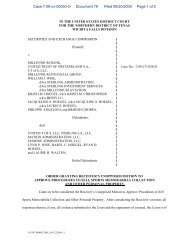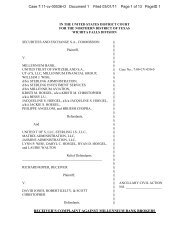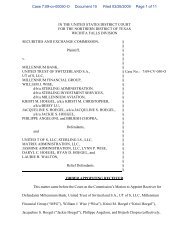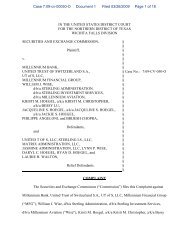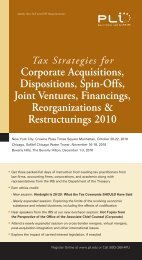View the full text of this document - Martindale.com
View the full text of this document - Martindale.com
View the full text of this document - Martindale.com
Create successful ePaper yourself
Turn your PDF publications into a flip-book with our unique Google optimized e-Paper software.
“Russian roulette,” allows each side to<br />
define in <strong>the</strong> investment agreement those<br />
preconditions <strong>of</strong> price and valuation<br />
under which it would be a buyer or seller.<br />
Provisions for binding mediation or<br />
arbitration would be a third possibility.<br />
The last resort for ei<strong>the</strong>r side is a courtmandated<br />
dissolution <strong>of</strong> <strong>the</strong> venture.<br />
Most private equity and venture investment<br />
models currently use ei<strong>the</strong>r “drag-along”<br />
or “tag-along” rights. In <strong>the</strong> former, <strong>the</strong><br />
investors can require <strong>com</strong>pany management<br />
to participate when <strong>the</strong>y find a buyer for<br />
<strong>the</strong>ir stake; in <strong>the</strong> latter, if a buyer is found<br />
for a certain percentage <strong>of</strong> <strong>the</strong> investment,<br />
both sides can sell that percentage <strong>of</strong> <strong>the</strong>ir<br />
ownership stakes. Because such opportunities<br />
can arise suddenly, Marx urges boards to<br />
<strong>com</strong>mission an annual <strong>com</strong>pany valuation<br />
by an outside accounting firm. “Most<br />
A Meeting <strong>of</strong> Equals<br />
When large corporate equals create a joint<br />
venture investment, many <strong>of</strong> <strong>the</strong>se same<br />
control and valuation issues should be<br />
addressed initially. “Both parties contribute<br />
something to such a venture,” Hertlein<br />
observes, “and establishing issues <strong>of</strong> fair<br />
value and depreciation upfront is essential<br />
to a successful transaction, particularly if<br />
<strong>the</strong> contribution <strong>of</strong> assets is not equal.”<br />
If <strong>the</strong> venture is not administratively selfsufficient,<br />
one or both sides must provide<br />
management services and value <strong>the</strong>m<br />
appropriately.<br />
Intellectual property rights are frequently<br />
central to large <strong>com</strong>pany ventures. The<br />
parties must decide from <strong>the</strong> start whe<strong>the</strong>r<br />
technology is given or licensed to <strong>the</strong> venture,<br />
and ei<strong>the</strong>r option has significant implications<br />
for IP ownership. To address <strong>the</strong> issue <strong>of</strong> who<br />
Technology Ventures: The Need for Flexibility<br />
As lead counsel in many s<strong>of</strong>tware manufacturing business <strong>com</strong>binations, Charles F.<br />
Hertlein Jr. urges clients to build maximum flexibility into transaction<br />
<strong>document</strong>ation because <strong>the</strong> industry changes so rapidly. “Technology ventures<br />
<strong>of</strong>ten evolve in unexpected directions, and ei<strong>the</strong>r partner may find that <strong>the</strong> <strong>full</strong>y<br />
developed venture is significantly different than <strong>the</strong>y anticipated,” he explains.<br />
“Once that happens, it is extremely difficult to renegotiate venture terms.”<br />
In one example, an engineering design <strong>com</strong>pany had created a new category <strong>of</strong><br />
workflow management s<strong>of</strong>tware. Because s<strong>of</strong>tware was not its core business, <strong>the</strong><br />
<strong>com</strong>pany entered a joint venture with ano<strong>the</strong>r industry participant to develop <strong>the</strong><br />
product. Five years later, <strong>the</strong> s<strong>of</strong>tware had be<strong>com</strong>e a significant growth business,<br />
and <strong>the</strong> <strong>com</strong>pany could only bring it back in-house by engaging Hertlein to<br />
negotiate a new agreement with significantly higher valuation—which could have<br />
been avoided by clear growth and control definitions in <strong>the</strong> original agreement.<br />
<strong>com</strong>panies do a single valuation at <strong>the</strong> start<br />
<strong>of</strong> a venture and never update it, which<br />
<strong>of</strong>ten creates valuation disputes later,” he<br />
says. “An annual valuation brings issues<br />
such as underfunded pension plans to <strong>the</strong><br />
surface, so <strong>the</strong>y can be resolved before<br />
<strong>the</strong>y be<strong>com</strong>e due diligence problems when<br />
selling an investment stake.”<br />
gets control <strong>of</strong> intellectual property developed<br />
by <strong>the</strong> venture itself, Hertlein and Marx<br />
suggest that <strong>the</strong> parties agree to license<br />
technology from <strong>the</strong> venture, with clear<br />
definition <strong>of</strong> ownership expiration rights.<br />
Particularly if <strong>the</strong> joint venture owners are<br />
public <strong>com</strong>panies, <strong>the</strong>re should be clear<br />
agreement on what and how much each<br />
party can consolidate from <strong>the</strong> venture into<br />
its own financial results. That includes<br />
<strong>the</strong> extent to which ei<strong>the</strong>r side can derive<br />
tax benefit from losses and depreciation.<br />
Financial agreement should also include<br />
agreement on <strong>the</strong> extent to which ei<strong>the</strong>r<br />
side may buy back its own or <strong>the</strong> o<strong>the</strong>r<br />
side’s investment stake. “In all <strong>the</strong>se<br />
considerations, it is essential that <strong>the</strong> parties<br />
anticipate and resolve negative eventualities<br />
beforehand,” Hertlein warns. “If a dispute<br />
arises, it is harder to force an exact division<br />
<strong>of</strong> asset ownership in a joint venture than it<br />
is in a marital divorce.”<br />
The Fundamental Rule<br />
Hertlein and Marx agree that one<br />
fundamental rule applies to all investment<br />
agreements, no matter what <strong>the</strong> size <strong>of</strong><br />
<strong>the</strong> parties or <strong>the</strong> nature <strong>of</strong> <strong>the</strong>ir business<br />
relationship: Make every effort during<br />
negotiations to anticipate future disputes.<br />
“The eagerness to get a deal done creates<br />
<strong>the</strong> temptation to minimize <strong>the</strong> likelihood<br />
<strong>of</strong> problems,” Hertlein warns. “Thinking<br />
through negative eventualities and how to<br />
address <strong>the</strong>m is one <strong>of</strong> <strong>the</strong> surest ways to<br />
avoid <strong>the</strong>m.”<br />
Dinsmore & Shohl LLP is a <strong>full</strong>-service<br />
law firm with more than 300 attorneys<br />
practicing in nine <strong>of</strong>fices. For <strong>the</strong> past 99<br />
years, Dinsmore & Shohl has provided a<br />
broad range <strong>of</strong> integrated services to<br />
meet <strong>the</strong> needs <strong>of</strong> both large and small<br />
businesses as well as institutions,<br />
associations, governments, pr<strong>of</strong>essional<br />
firms and individuals.<br />
Article Participants:<br />
Charles F. Hertlein Jr.<br />
Partner, Corporate<br />
chuck.hertlein@dinslaw.<strong>com</strong><br />
Peer Review Rated<br />
James A. Marx<br />
Partner, Corporate<br />
james.marx@dinslaw.<strong>com</strong><br />
JULY 2007<br />
27



